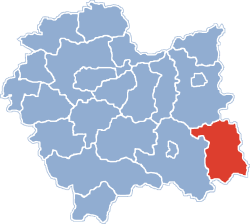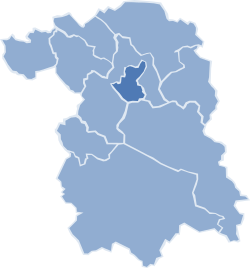Gorlice County Powiat gorlicki | |
|---|---|
 Location within the voivodeship | |
 Division into gminas | |
| Coordinates(Gorlice): 49°39′N21°10′E / 49.650°N 21.167°E | |
| Country | |
| Voivodeship | Lesser Poland |
| Seat | Gorlice |
| Gminas | Total 10 (incl. 1 urban) |
| Area | |
• Total | 967.36 km2 (373.50 sq mi) |
| Population (2019) | |
• Total | 116,865 [1] |
| • Urban | 35,168 |
| • Rural | 81,697 |
| Car plates | KGR |
| Website | http://www.powiat.gorlice.pl |
Gorlice County (Polish : powiat gorlicki) is a unit of territorial administration and local government (powiat) in Lesser Poland Voivodeship, southern Poland, on the Slovak border. It was created on 1 January 1999 as a result of the Polish local government reforms passed in 1998. Its administrative seat and largest town is Gorlice, which lies 100 kilometres (62 mi) south-east of the regional capital Kraków. The only other towns in the county are Biecz, lying 12 km (7 mi) north-east of Gorlice, and Bobowa, 18 km (11 mi) west of Gorlice.
Contents
The county covers an area of 967.36 square kilometres (373.5 sq mi). As of 2019 its total population is 116,865, out of which the population of Gorlice is 27,442, that of Biecz is 4,590, that of Bobowa is 3,136, and the rural population is 81,697.



